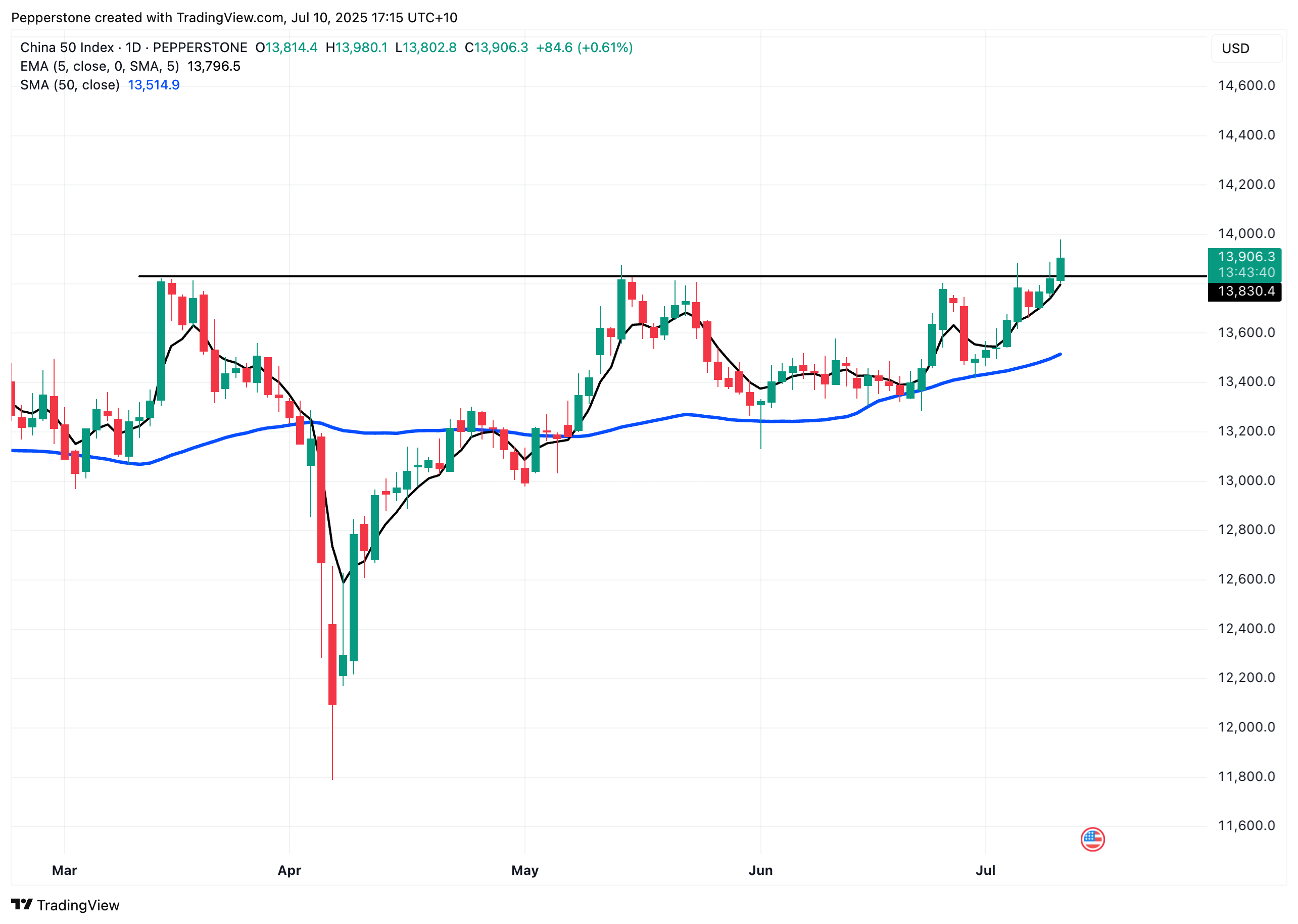CFDs are complex instruments and come with a high risk of losing money rapidly due to leverage. 81.1% of retail investor accounts lose money when trading CFDs with this provider. You should consider whether you understand how CFDs work and whether you can afford to take the high risk of losing your money.
- English
- 简体中文
- 繁体中文
- ไทย
- Tiếng Việt
- Español
- Português
- لغة عربية
As markets grapple with shifting tariff releases and U.S. stocks hesitate at lofty levels, CN50 has successfully broken through the key resistance level of 13,830, which had capped gains multiple times in March and May.

It is now hovering near 13,900, marking a new year-to-date high. In my view, this rally has been driven by the confluence of three factors: improving macro data with a degree of comparative advantage, the lack of immediate transmission of tariff shocks, and the continued release of policy-driven capital inflows.
China’s Economy: Not Shining, But Showing Signs of Life
From a fundamental perspective, while China’s economic data is not particularly strong, it has shown signs of marginal improvement. June CPI turned positive for the first time in several months and came in well above market expectations. The market has taken this as an early sign of easing deflationary pressure, which has boosted risk appetite.
At the same time, several international investment banks have revised up their growth forecasts for China’s GDP, while the U.S. economy faces increasing downside risks. The Federal Reserve’s June meeting minutes flagged concerns over inflationary pressures from tariffs and a weakening labor market, yet policymakers still appear cautious on rate cuts.
Additionally, the U.S. faces mounting debt issues, and U.S. equity valuations remain elevated, making investors more hesitant to buy in. In comparison, China’s macro fundamentals are starting to look more attractive, prompting some overseas funds to rotate into CN50 and other core Chinese assets.
Tariff Threats Make Noise, But Markets Stay Calm
Trump's renewed tariff threats - while loud - haven’t translated into immediate market damage. From signing a trade deal with Vietnam to threatening a 10% tariff on economies aligned with BRICS positions, these actions, while indirectly pointing to China, have not translated into immediate market consequences. The U.S.-China tariff truce remains in effect until mid-August.
Given that both sides hold critical bargaining chips - China with rare earths, the U.S. with semiconductors - there is still ample room for negotiation. Comparatively, U.S. equities have been put on hold due to uncertainty stemming from Trump’s statements, and European markets remain largely dependent on favorable outcomes from trade discussions with the U.S. By contrast, CN50 appears to be relatively insulated from these disruptions in the short term.
Policy Support Flows Like Fresh Water into CN50
A steady stream of policy-driven capital inflows is providing solid support. The ongoing integration of financial markets between mainland China and Hong Kong is proving to be a structural tailwind. The inclusion of RMB stock counters in the Stock Connect program, the expansion of Southbound Connect to insurance and asset management institutions, and the rollout of Hong Kong’s Stablecoin Ordinance in August are all steadily improving cross-border financial infrastructure.
For the CN50, which is heavily weighted toward financials, technology, and consumer sectors, these developments are undoubtedly providing fresh liquidity from institutional capital.
Overall, CN50’s strong rebound is a natural outcome of investors seeking new directions amid heightened global uncertainty. At this stage, CN50 is demonstrating relative stability and structural support. In the near term, U.S.-China trade negotiations remain a key variable.
Trade Talks: Complexity Breeds Opportunity
Since both sides hold cards the other needs, the next phase of talks may move beyond unrealistic tariff hikes and shift toward enforcement mechanisms, compliance issues, and rules around origin tracing. While this adds complexity, it also opens the door for compromise and a potential easing of tensions. Any signs of de-escalation could further support CN50 performance.
China’s activity data - including industrial production, retail sales, and trade figures - will be crucial in determining whether this rally has staying power. As things stand, market sentiment and the broader narrative are gradually tilting in China’s favor, and CN50 is responding accordingly.
The material provided here has not been prepared in accordance with legal requirements designed to promote the independence of investment research and as such is considered to be a marketing communication. Whilst it is not subject to any prohibition on dealing ahead of the dissemination of investment research we will not seek to take any advantage before providing it to our clients. Pepperstone doesn’t represent that the material provided here is accurate, current or complete, and therefore shouldn’t be relied upon as such. The information, whether from a third party or not, isn’t to be considered as a recommendation; or an offer to buy or sell; or the solicitation of an offer to buy or sell any security, financial product or instrument; or to participate in any particular trading strategy. It does not take into account readers’ financial situation or investment objectives. We advise any readers of this content to seek their own advice. Without the approval of Pepperstone, reproduction or redistribution of this information isn’t permitted.
.jpg)